What is ENTRY?
ENTRY is a blockchain-based banking service designed to increase the flow of cryptocurrencies in the real economy. It is an AI empowered multi-utility financial platform. ENTRY is designed to allow people to use fiat as well as crypto currencies in their day-to-day purchases without really having to be concerned about the technology behind the system. ENTRY envisions becoming a truly global bank in the post fiat world. Its entire framework is structured to enhance utility of all crypto Tokens and simultaneously facilitate all those who still want to transact in fiat. ENTRY’s suite of products allows it to touch the financial lives of every crypto user and change it for the better.
Why ENTRY?
The global financial crisis revealed significant weaknesses in the existing financial system and some of the vulnerabilities have already exhibited their impact on the interconnected global market. The world economy is still struggling with sluggish real growth today. Transferring money for remittance, money lending across international borders is still very complicated, time consuming and expensive. Existing systems running on traditional banking channels are slow and full of intermediaries, higher exchange rates, counter-party risks, bureaucracy and extensive paperwork9 . ENTRY’s business model is focused on disrupting the existing pillars of finance who only act as toll-keepers without providing any value-add to consumers and businesses. Removing the numerous intermediaries would make the system faster, more secure and cost-effective for all involved.

ENTRY is a blockchain - based platform empowered by smart contracts; it which not only acts as a bank by offering easy deposits, payment and lending services, cross-border payments, ATM facility/convenient withdrawals, but also as a cryptocurrency exchange for the business and consumer world.
Mission Statement:
To be the gateway between traditional and new financial paradigms and systems led by cryptocurrencies and empower the financial ecosystem to have a framework that allows for interoperability between the two. We aim
To help cryptocurrencies achieve suitability for everyday transactions and open the world of crypto-finance to every citizen.
To keep a transparent record of all the transactions in the ecosystem.
To expand the use of cryptocurrencies for purchase and payments across the business world.
To create a simple and all-in-one platform to revolutionize the traditional methods of dealing with banking systems.
ENTRY’s suite of comprehensive banking products and services will ensure a new benchmark in banking and financial services.
PROBLEM AND MARKET SCENARIO
The financial crisis of 2008-2009 led the general public to lose faith in the global banking system. This distrust was one of the prime motivations in the birth of Bitcoin, a cryptocurrency developed by a person or a group of people named Satoshi Nakamoto. The loss of trust in the banks led to the emergence of a peer-to-peer “trustless” electronic cash system based on a technology called blockchain.

THE INTERMEDIARY WILL FADE AWAY
The fundamental value proposition of the blockchain is that it eliminates the need for trust — a commodity without which exchanges of value (transactions) cannot happen. This means that individuals and businesses can do away with a whole bunch of intermediaries whom they pay for managing trust. 2
Bitcoin is just one application of the new technology (blockchain). The advent of cryptocurrencies has led to a worldwide boom where new innovations are being brought onboard structured through pioneering crypto Tokens to disrupt existing traditional industries.

SURGE IN CASHLESS PAYMENTS
Global non-cash transaction volumes grew 11.2% during 2014-2015 to reach USD 433.1 billion, the highest growth of the past decade. Debit card and credit card transfers were the leading instruments in 2015, while check usage continues to decline globally. Debit card accounted for the highest share (46.7%) of the global non-cash transactions followed by credit cards with 19.5% in 2015.
The RBR (Retail Banking Research) study shows that the share of credit transfers has also increased. They tend to be used for high-value payments, such as salaries and business-to-business payments, and account for 89% of the value of cashless payments.
The impressive growth of cashless transactions will continue, with cards increasingly being used for low-value payments, supported by the spread of contactless cards and EFTPOS terminals. Meanwhile, growth in credit transfers is being aided by the implementation of systems enabling

Webseite: https://entry.money/
WhitePaper: https://entry.money/ENTRY_Whitepaper_v1.pdf
Twitter: https://twitter.com/EntryMoneyICO
Facebook: https://www.facebook.com/entrymoney/
Telegramm: https://t.me/Entry_Official








No comments:
Post a Comment